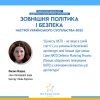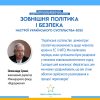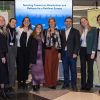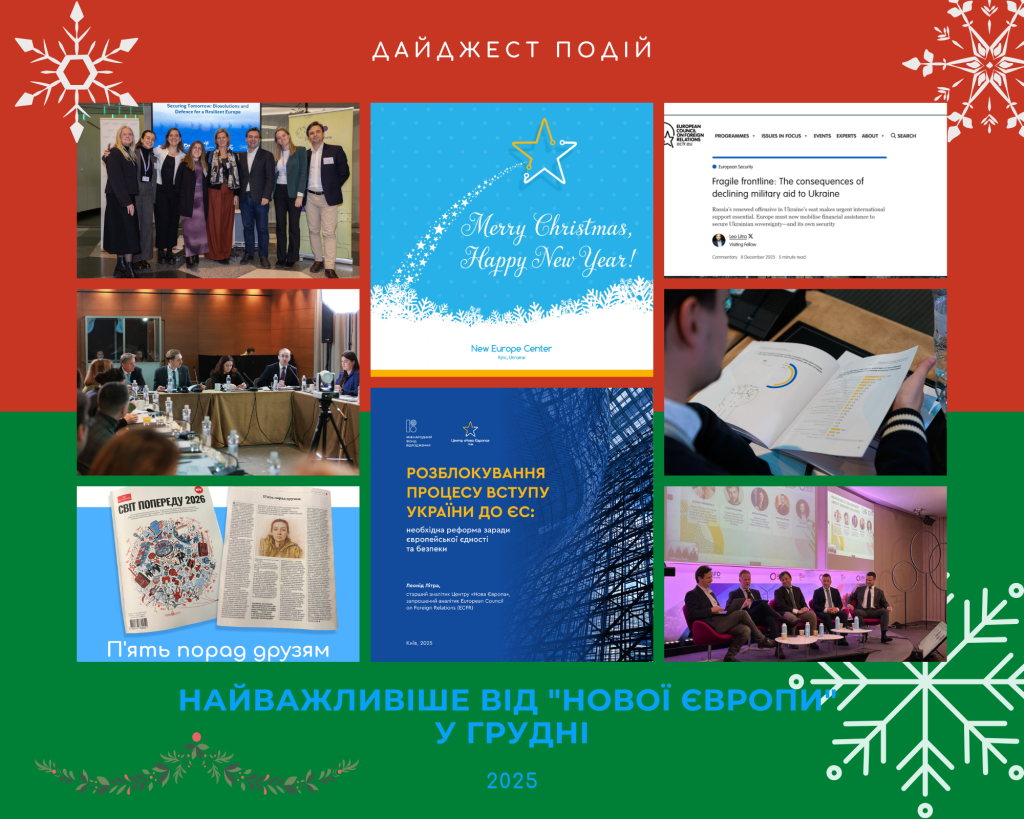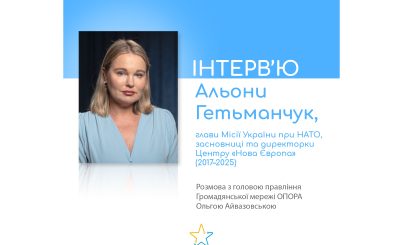PDF-версія документа доступна тут.
Публікація видана в межах Ініціативи з розвитку аналітичних центрів в Україні, яку виконує Міжнародний фонд «Відродження» у партнерстві з Ініціативою відкритого суспільства для Європи (OSIFE) за фінансової підтримки Посольства Швеції в Україні.
Думки та позиції викладені у цій публікації є позицією автора та не обов’язково відображають позицію Посольства Швеції в Україні, Міжнародного фонду «Відродження» та Ініціативи відкритого суспільства для Європи (OSIFE).
***
Авторка висловлює вдячність за можливість проходження стажування у Словаччині в межах Ініціативи з розвитку аналітичних центрів в Україні, яку виконує Міжнародний фонд «Відродження» у партнерстві з Ініціативою відкритого суспільства для Європи (OSIFE) за фінансової підтримки Посольства Швеції в Україні.
Щира подяка Дослідницькому центру Словацької асоціації зовнішньої політики, особисто експерту Александру Дулебі, за цінні поради та надану можливість зібрати необхідні для дослідження дані. Не меншу вдячність адресуємо послу Словаччини в Україні Мареку Шафіну, Сергію Солодкому, Марині Воротнюк, Яні Кобзовій, Григорію Месежнікову, Михайлу Гончару, Карелу Хірману, Йозефу Баторі та усім іншим фахівцям за їх вклад у дослідження.
Вільні від історичних тягарів та проблемних питань наші відносини не набули системного характеру, а радше є історією недооцінених можливостей. Незважаючи на різні політичні кольори словацьких урядів, Словаччина зацікавлена у співпраці з Україною та її європейській інтеграції.
Україна та Словаччина залишаються “terra incognita” одна для одної, можливо, через брак інтересу. Втім, словаки завжди були симпатиками ідей панславізму. Панславізм вперше був сформований чеськими та словацькими інтелектуалами в середині XIX століття. Ця ідеологія відображала прагнення до об’єднання всіх слов’янських народів. Росія, в свою чергу, сприймалась словацькими націоналістами як єдиний союзник, який мав стати захисником слов’ян.
Інший підхід до Росії має колишній прем’єр-міністр Роберт Фіцо (лідер лівої партії Smer-SD), відомий заявами про контрпродуктивність антиросійських санкцій та заграваннями з Росією. Втім, його уряд погодився з усіма обмежувальними заходами проти Росії, схваленими ЄС, та реалізував реверсне постачання газу до України, попри ймовірність виключення Фіцо зі списку друзів Росії після такого кроку). Чинний прем’єр-міністр Петер Пелегріні (член партії Smer-SD), який за свідченнями словацьких співрозмовників, лише номінально обіймає посаду, не проявив себе у політиці щодо України, він просто мовчить про неї. Суперечності у риториці політиків і їхніх діях пояснити досить просто: політичні діячі почасти роблять заяви, які хотіли б від них почути виборці. Пересічні словаки сприймають Росію переважно прихильно. Крім того, якими б проросійськими не були словаки, але в критичні моменти, спровоковані деструктивною політикою Росії, західні партнери надавали Братиславі максимальну підтримку (газова криза 2009 року).
Для частини словацького політикуму досить близька російська призма сприйняття України. Саме серед них популярний російський наратив щодо війни на Донбасі, так само усталена думка про Україну як “failed state”. Так, спікер парламенту Словаччини Андрей Данко виступає проти політики ЄС щодо РФ та зберігає активний контакт зі спікером російської Думи Вячеславом Володіним. Його правоконсервативна Словацько-національная партія (SNS), що входить у коаліційний уряд, заблокувала імплементацію оновлених стратегій безпеки та оборони Cловаччини влітку 2018 року. Причиною такого кроку стали деякі пункти, де Росія охарактеризована як агресивна країна. Серед інших прикладів – торішнє відвідування депутатом Петером Марчеком разом із декількома бізнесменами та колишнім заступником голови словацької Служби розвідки анексованого Криму, що в коаліційному уряді було засуджено відкрито лише лідером ліберальної партії угорської меншини Most-Hid; а також рішення не видворяти російських дипломатів після подій у Солсбері.
Ще однією загрозою українсько-словацьким відносинам можуть бути зміни у політиці Словаччини щодо України внаслідок парламентських виборів, які відбудуться в лютому 2020 року. У 2014 році Роберт Фіцо програв президентські вибори, а в 2016 році партії Фіцо довелося сформувати коаліційний уряд, адже вона втратила більшість, отримавши 28% голосів[v]. Нещодавні вибори до Європарламенту з перемогою коаліції PS-SPOLU, новостворених ліберальних партій SPOLU та Прогресивна Словаччина (віце-президентом якої була Зузана Чапутова) стали черговим сигналом послаблення політичної сили Фіцо[vi]. Відповідно, перемога Чапутової – це продовження хвилі змін у словацькій політиці. Деякі словацькі співрозмовники мають очікування, що після парламентських виборів Словаччина отримає новий уряд, альтернативний Фіцо. Є і ті, хто зазначають ймовірність розділу партії через конфлікт між Робертом Фіцо та Петером Пелегріні.
Словацький політичний простір досить сегментований – судячи з усього, до парламенту потрапить до дев’яти партій. У нинішньої опозиції, до якої належить і політична сила президентки країни, є всі шанси сформувати урядову коаліцію. До неї можуть увійти одразу п’ять партій: коаліція PS-SPOLU, Za ľudí (партія екс-президента Кіски), SaS (невелика ліберальна правоцентристська партія), OĽaNO (ще одна мала партія консерваторів) та Християнсько-демократичний рух (KDH) (раніше кілька разів входили до урядових коаліцій). PS-SPOLU і KDH нещодавно заключили пакт про ненапад під час виборчої кампанії[vii].
Існують і виборці, які досі не визначилися, що може змінити баланс між партіями, дозволивши політичній силі Фіцо Smer-SD (яка з 19,6% все ще лідирує за рівнем підтримки) отримати більше голосів та домовитися про коаліцію з позасистемною партією Бориса Коллара “Sme Rodina” та навіть право радикальною “Народною партією – Наша Словаччина” (L`SNS) на чолі з Маріаном Котлебою. Так, Верховний суд Словаччини 3 вересня офіційно позбавив мандата члена парламенту Мілана Мазурека (L’SNS). Причиною стали расистські висловлювання депутата щодо ромів, і це перший подібний випадок в історії країни. Прикметно, що Фіцо публічно захистив депутата.
L`SNS за результатами останнього опитування агенції AKO отримала 10,9%[viii]. Члени партії захоплюються маріонетковим урядом, який правив Словаччиною в роки Другої світової війни. Цю партію називають відкрито профашистською, з антиромськими та антисемітськими позиціями, а її підтримку частково пояснюють прагненням словаків висловити своєрідний протест. Також деякі співрозмовники зазначили, що партію Котлеби недооцінювали, особливо після його перемоги на регіональних виборах в м. Банська Бистриця. На виборах до Європарламенту ця партія посіла третє місце.
Після нещодавньої відмови Штефана Гарабіна, ультраправого кандидата в президенти, боротися за посаду судді Верховного суду існує ймовірність, що він може створити партію. У процесі створення політичної сили перебуває і колишній міністр охорони здоров’я Томаш Друкер, раніше член партії Smer-SD.
Економічна співпраця: нерозкритий потенціал
Всупереч міфу, що антиросійські санкції суттєво шкодять економікам країн-членів ЄС, зокрема Словаччини, згідно з дослідженням Центру “Нова Європа”, скорочення словацького експорту до РФ у 2014-2017 роках склало лише 3,7%[ix]. При цьому російська частка в загальному обсязі імпорту, який надійшов до Словаччини в 2018 році, – 5,3%, а частка експорту Словаччини до РФ – 1,9%[x].
Втім, економічна співпраця між Словаччиною та Україною теж не є дуже активною. У 2018 році двосторонній товарообіг склав 1 389,8 млн доларів США та збільшився порівняно з 2017 роком на 19,3%. Позитивне сальдо для України за цей період склало 338,2 млн доларів США[xi].
Прикметно, що останнє засідання Спільної комісії з економічного, промислового та науково-технічного співробітництва відбулося у вересні 2013 року. Така інтенсивність діяльності комісії слугує прикладом недооцінки економічної співпраці або неефективної міжвідомчої комунікації. Крім того, часто керівництво середніх та малих підприємств Словаччини не довіряє непередбачуваному бізнес-середовищу України.
Україна експортує та імпортує до Словаччини в основному сировинну продукцію. Серед перспективних напрямків співпраці – автомобілебудування, металургія (експорт не сировини, а продукції з більшою доданою вартістю), авіаційна сфера (зокрема, в царині наукових розробок та освіти, спільних проектів), туризм та сфера транзитних перевезень. Цікавою може бути співпраця в сфері технологічних інновацій та стартапів.
Словаччина та Україна мають великий потенціал для популяризації туристично-реакреаційної галузі. За даними Всесвітнього економічного форуму, за останні два роки Україна піднялася на 10 пунктів в Індексі конкурентоспроможності в сфері подорожей і туризму[xii]. Торік відбулося перше засідання Українсько-словацької спільної туристичної комісії, що стало гарним стартом співпраці, як і запуск авіарейсу з Братислави до Одеси. Доцільним є створення туристичного сайту та відповідної вкладки на сторінці Посольства України в Словаччині. Також цікавим буде запрошення популярних туристичних блогерів або інфлюенсерів зі Словаччини до України та навпаки з подальшою промоцією серії роликів серед словацької та української аудиторій.
Важливо відзначити і обмін досвідом між експертами Міністерства фінансів Словаччини та українськими колегами: допомогу у проведенні реформ, зокрема підтримки розвитку ринкового середовища через програму SlovakAid[xiii] та діяльність Івана Міклоша, колишнього словацького урядовця та голови стратегічної групи радників з підтримки реформ при попередньому Кабміні.
Енергетика: довгострокове партнерство або пост-майданний епізод?
Енергетику можна вважати локомотивом співпраці України та Словаччини. Проект реверсу природного газу зі Словаччини до України через газогін “Вояни-Ужгород” демонструє стратегічну важливість Словаччини у сфері енергетичної безпеки України. Частка Словаччини в транзиті природного газу з Європи до України в 2018 році становила 81,4% (для порівняння частка Польщі – 2,9%)[xiv]. Спільним інтересом обох країн є також продовження транзиту російського газу в Західну Європу та протидія проекту “Північний потік 2”, враховуючи перспективу його запуску через пару років.
Наразі триває також процес анбандлінгу[xv], тобто має з’явитися незалежний оператор ГТС, що вплине на подальшу комунікацію з партнерами та залучення європейців, зокрема словацької компанії Eustream, до повноцінного управління ГТС України. Якщо анбандлінг не відбудеться, почнуться системні проблеми, які торкнуться внутрішнього ринку газу і транзиту. Варто враховувати і контракт між “Нафтогазом” та “Газпромом”, який закінчується 1 січня 2020 року. Словаччина зацікавлена у продовженні співпраці по реверсу й у разі необхідності здатна підвищити потужність та рівень безпеки газопроводу Вояни-Ужгород. Критично важливими у даному випадку будуть українська комунікаційна стратегія та пряма взаємодія зі словаками після 1 січня 2020 року. Доцільним є створення “гарячої лінії” на корпоративному та міністерському рівнях для уникнення браку комунікації, як це було в 2009 році.
Ще одним перспективним аспектом співпраці є реалізація проектів з енергоефективності і відновлюваних джерел енергії та імплементація словацьких кращих практик у цій сфері. Сьогодні у Словаччині понад 50% панельних будинків утеплені і модернізовані, це один з найкращих показників на тлі інших постсоціалістичних європейських країн. Термомодернізація їх житлового фонду почалася на початку 90-х років, тому наразі Україна у Словаччині може запозичувати найкращі, вже адаптовані до пострадянської інфраструктури приклади, уникаючи помилок. Наприклад, цікавим є досвід словацького міста Трнава, яке є повністю енергонезалежним, або ТЕЦ компанії Thermonovaa.s у м. Нова Дубниця, що працює на біомасі, забезпечуючи 12-тисячне місто теплом та електроенергією. Словацький досвід став у нагоді і при створенні Фонду енергоефективності в Україні.
Крім того, Словаччина може допомогти Україні інтегруватися в центральноєвропейський ринок електроенергії, що розвивається. Поступове включення України до створення регіонального енергетичного ринку є довгостроковою метою, але воно має розглядатися як стратегічна основа для двостороннього українсько-словацького співробітництва в галузі енергетики. Співпраця зі Словаччиною буде корисною для подальшого підключення України до ENTSO-E (європейської мережі системних операторів). Втім, Україна повинна мати чіткий план приєднання до ENTSO-E із реалістичними та досяжними цілями та дедлайнами. Наразі одним із пріоритетних проектів є реконструкція ліній електропередач Мукачево-Вельке Капушани, що дозволить розширити їхню пропускну потужність.
Підземні сховища газу України можуть стати основою для співпраці щодо зберігання газу в майбутньому, якщо будуть відповідні передумови для створення Східноєвропейського газового хабу на базі газових ринків України, Словаччини, Польщі, Чехії, Угорщини та Румунії. У липні німецька компанія RWE, один з ключових гравців європейського газового ринку, скористалася послугою зберігання газу в режимі “митний склад” на території України. Якщо цей експеримент буде вдалим, прийдуть і інші зацікавлені партнери. До 2021 року має завершитися поєднання ГТС Словаччини і Польщі. Україна стає учасником енергетичного коридору «Північ – Південь». В майбутньому можливості співпраці з сусідами, ймовірно, збільшаться.
У підсумку, імпульс, який з’явився в українсько-словацькій енергетичній співпраці після Майдану, має бути зафіксований у двосторонніх відносинах, якщо ми хочемо зробити наше партнерство дійсно довгостроковим.
Інтегроване управління кордонами і транскордонна співпраця
Співпраця між Закарпаттям та Східною Словаччиною спирається на спільні проблеми: економічні, інфраструктурні тощо. Вона була оформлена із виникненням Карпатського єврорегіону в 1993 році за участі прикордонних регіонів України, Польщі, Словаччини, Румунії та Угорщини. Масштаби єврорегіону робили його функціонування та інституційний розвиток складним. Цей формат потребує реорганізації. Рух людей, транспорту і товарів через кордон більшою мірою залежить від стану відносин між Україною та ЄС, але українсько-словацького елементу у транскордонній співпраці бракує.
Задля зближення прикордонних регіонів доцільним буде створення нового білатерального єврорегіону, більш організаційно та інституційно якісного, або започаткування фонду Закарпаття та Кошицького самоврядного краю чи Прешовського з метою відбору та фінансування спільних проектів. Проблемами для розвитку є брак власного фінансування (залежність від фондів ЄС) та несталість проектів, які вже були втілені. І, безумовно, така співпраця залежить від політичної волі двох країн.
Важливим аспектом є запровадження спільного контролю на кордоні, що дозволить значно скоротити час перетину у пропускних пунктах та збільшити ефективність переміщення осіб, товарів і транспортних засобів. На сьогодні спостерігається брак спільного планування, проблема нерозвиненої прикордонної інфраструктури. Гарним рішенням стало б започаткування логістичних центрів, які будуть надавати широкий спектр послуг.
Для стимулювання економічного розвитку східних регіонів Словаччини та Закарпаття доцільним було б зробити акцент на проектах економічного розвитку. Потенційно перспективними є проведення бізнес-форумів (як це було започатковано в Кошице), ярмарок, приміром, MadeinUkraine, тощо. Ці домовленості можуть бути досягнуті під час засідання спільної Комісії з транскордонного співробітництва.
Відновлення роботи Міжнародного аеропорту “Ужгород”, унікального, бо літаки злітають і заходять на посадку через повітряний простір Словаччини, стало гарним прикладом співпраці України та Словаччини у покращенні умов життя мешканців прикордонного регіону. Це може дати імпульс розвитку туризму не тільки на Закарпатті, а й у прикордонних регіонах Словаччини. Аеропорти в Ужгороді та Кошице стратегічно важливі для прикордоння, тому координація їхнього розвитку могла б бути корисною. Тут слід також відзначити запуск потягу Кошице-Мукачево з червня цього року. Перспективним наразі є і будівництво летовища в Мукачеві, що було анонсовано попереднім урядом[xvi].
Українці в Словаччині
Кількість українців у Словаччині стабільно зростає. Новим елементом наших відносин стають студенти та трудові мігранти. За належного підходу та координації вони можуть поширювати позитивні меседжі серед словацької аудиторії, пояснюючи специфіку України.
Демографічний занепад у країнах Центральної Європи та виїзд працездатного населення до Західної Європи спричинили зацікавленість Словаччини в додатковій робочій силі з третіх країн та зміну її міграційної політики. За розрахунками кількість працездатного населення Словаччини з 2013 до 2060 року зменшиться на 37 %[xvii]. У листопаді 2018 року уряд Словаччини погодився на додаткові зміни до законів щодо служб зайнятості та перебування іноземних громадян з метою спрощення працевлаштування громадян третіх країн.
Частка українців у структурі закордонних трудових мігрантів у Словаччини досягла 13,2 %[xviii]. Для порівняння в 2014 було 4,9%. На кінець 2018 року в Словаччині перебували майже 25 тисяч громадян України, з них 20,5 тисяч – тимчасові, а 4,4 тисячі осіб – постійні[xix]. Це робить їх найбільшою групою з третіх країн, яка проживає в Словаччині. Також необхідно враховувати нелегальних мігрантів, точних даних щодо яких немає, але, за словами словацьких співрозмовників, половину з цих мігрантів становлять українці. Як свідчить спеціалізоване дослідження, тема економічної міграції є дуже токсичною і породжує різні міфи серед словаків, але навколо української трудової міграції такого поки немає[xx].
Швидке зростання кількості українських студентів за останні кілька років теж збіглось із соціодемографічними тенденціями. Зросла як абсолютна кількість українських студентів (зі 188 студентів денної форми навчання у 2013/2014 до 1851 студентів у 2017/2018), так і частка українських студентів серед усіх іноземних студентів у Словацькій Республіці (з 3% у 2013/2014 до майже чверті всіх іноземних студентів у 2017/2018)[xxi]. Студентські обміни, академічні кластери, поширення українських меседжів студентами серед молоді будуть сприяти зміцненню позитивного іміджу України серед словаків та поступовому відходженню від контексту корупції і війни у сприйнятті України.
Рекомендації:
- Організувати візит президента України до Словаччини. Візит Володимира Зеленського до Братислави продемонструє, як Україна цінує підтримку Словаччини в різних сферах. Наразі в Словаччині звертають увагу на дисбаланс візитів: словацька верхівка набагато частіше бувала в Україні, аніж українська – в Словаччині.
- Активізація діалогу зі словацькими “друзями України”. Інвестиції в спілкування на рівні експертів, лідерів думок та ЗМІ Словаччини є життєво важливими. У країні не вистачає експертів, які знають про внутрішню ситуацію в Україні та здатні надати компетентні коментарі. Україна найчастіше асоціюється з війною, корупцією та Кримом. Критично важливими є візити експертів та журналістів (наприклад, study tours), спільні проекти аналітичних центрів, академічні обміни.
- Встановити інтенсивне міжпарламентське партнерство. За словацький напрям двосторонньої міжпарламентської співпраці мають відповідати депутати, які розуміють словацьку специфіку або принаймні мають уявлення про співпрацю в Центральній Європі. Після парламентських виборів у Словаччині в лютому 2020 року найімовірніше склад Національної Ради суттєво оновиться, Верховна Рада України теж змінила свій склад. Обмін візитами «груп дружби» двох країн стане гарним стартом для налагодження контактів – Україна у цьому сенсі могла б проявити ініціативу.
- Акцентувати увагу на українсько-словацькій транскордонній співпраці. Розглянути можливість створення спільного фонду Закарпаття та Прешовського чи Кошицького самоврядних країв для відбору та фінансування спільних проектів на постійний основі. Це питання може бути обговорено під час засідання українсько-словацької міжурядової комісії з транскордонного співробітництва.
- Впровадити інтегроване управління кордоном та збільшити пропускну здатність пунктів перетину спільного кордону між Україною та Словаччиною. Це допоможе вирішити проблему довгих черг на кордоні.
- Підтримувати активну комунікацію з українцями Словаччини, які стають вагомою частиною словацького суспільства. Йдеться як про тих українців, які мешкають в країні вже давно, так і про тих, хто лише прибув – студенти, трудові мігранти (їхня кількість стабільно зростає). Чим більше знатимуть словаки про Україну, тим більше буде можливостей протидіяти антиукраїнським заходам Кремля та тим далі ми будемо відходити від образу України у свідомості словаків як “terra incognita”.
- Активніше співпрацювати зі словацькими колегами щодо енергетичної безпеки в регіоні. Доцільним є створення “гарячої лінії” на корпоративному та міністерському рівнях для уникнення браку комунікації з 1 січня 2020 року. Продовжувати обмін досвідом між Словаччиною та Україною у сфері реформування енергетичного сектору. Словаччина здатна поділитися з Україною досвідом адаптації національного законодавства до енергетичної політики ЄС, енергоаудиту, енергозбереження, використання біомаси тощо.
- Завершення анбандлінгу та залучення європейських партнерів, зокрема словацької Eustream, до управління ГТС України. Словацька компанія зацікавлена в участі у повноцінному консорціумі після створення незалежного оператора ГТС України.
- Мати чітку стратегію з дедлайнами та завданнями щодо підключення до загальноєвропейської енергосистеми ЕNTSO-E. Під час втілення цієї стратегії актуальними кроками будуть реконструкція ліній електропередач та посилення спільних електромереж відповідно до стандартів безпеки ЕNTSO-E.
- Удосконалити механізм інформування українських виробників про процедуру виходу на словацький ринок та інші технічні деталі. Цьому буде сприяти злагоджена робота на всіх рівнях – Ради експортерів та інвесторів при МЗС, торговельно-промислових палат, управлінь ЗЕД при обласних державних адміністраціях тощо, що дозволить уникати і дублювання функцій. Одним із цікавих заходів могла б бути спільна організація ярмарки стартапів або виставки “MadeinUkraine” для збільшення і диверсифікації українського експорту, також необхідно продовжувати організацію місій словацьких бізнесменів до України та проведення спільних бізнес-форумів.
Джерела:
[i]GLOBSEC Trends 2018 Central Europe: One Region, Different Perspectives,
[ii] GLOBSEC Trends 2019: Central and Eastern Europe 30 years after the fall of the Iron Curtain, https://www.globsec.org/publications/globsec-trends-2019/
[iii] Президентка Словаччини розповіла про підтримку України і своє бачення діалогу з РФ, https://www.eurointegration.com.ua/news/2019/06/26/7097778/
[iv] SR-Ukrajina: Politické rokovania i humanitárna pomoc, https://www.mzv.sk/aktuality/detail/-/asset_publisher/Iw1ppvnScIPx/%20content/-sr-ukrajina-politicke-rokovania-i-humanitarna-pomoc/10182
[v]The 2016 elections in Slovakia: a shock, https://cz.boell.org/en/2016/03/22/2016-elections-slovakia-shock
[vi]EP election in Slovakia: Official results confirm the victory of pro-EU forces,
[vii]PS, Spolua KDH sachcú rozprávať slušne, majú paktoneútočení (video), https://video.sme.sk/c/22164806/progresivne-slovensko-spolu-a-kdh-maju-pakt-o-neutoceni-video.html
[viii]Prieskum: Kiskova strana sa doťahuje na SaS, kotlebovci klesli, https://www.aktuality.sk/clanok/721354/prieskum-kiskova-strana-sa-dotahuje-na-sas-kotlebovci-klesli/?fbclid=IwAR0t8rAF-30eU4lNH6aMN8S7IhB6WEGvca6S7HgAWjrsd2fvksQvHCyQEIs
[ix]Хто перший: Які країни наважаться порушити єдність Європейського Союзу щодо санкцій проти Росії?
[x] Total Import and Total Export by continents and economic groupings, http://statdat.statistics.sk/cognosext/cgi-bin/cognos.cgi?b_action=cognosViewer&ui.action=run&ui.object=storeID(%22i10B2CB52FFF44B319DA31F65A3FFE155%22)&ui.name=Total%20Import%20and%20Total%20Export%20by%20continents%20and%20economic%20groupings%20in%202014%20%5bzo0002ms%5d&run.outputFormat=&run.prompt=true&cv.header=false&ui.backURL=%2fcognosext%2fcps4%2fportlets%2fcommon%2fclose.html&run.outputLocale=en
[xi]Державна служба статистики, http://www.ukrstat.gov.ua
[xii]Travel&TourismCompetitivenessIndex, https://www.weforum.org/reports/the-travel-tourism-competitiveness-report-2019
[xiii]MF SR development cooperation activities, https://www.finance.gov.sk/en/european-international-affairs/development-cooperation/mf-sr-development-cooperation-activities/
[xiv]У 2018 році Україна закупила 10,6 млрд куб. м газу з європейського напряму,
http://www.naftogaz.com/www/3/nakweb.nsf/0/2AFFDE2203E7BBA3C22583900050CD59?OpenDocument&Highlight=0, Словаччина
[xv]“Анбандлінг” – це відокремлення діяльності з транспортування природного газу (діяльності Оператора ГТС) від видобутку і постачання природного газу та електричної енергії.
[xvi]Анонсовано початок будівництва летовища в Мукачеві, https://pershij.com.ua/anonsovano-pochatok-budivnytstva-letovyshcha-v-mukachevi/
[xvii] Phantom Menace. The politics and Plocies of Migration in Central Europe. Jacek Kucharczyk and Grigorij Meseznikov (eds.). Institute of Public Affairs, 2018. 267p.
[xviii]Ibid.
[xix]https://www.minv.sk/swift_data/source/policia/hranicna_a_cudzinecka_policia/rocenky/rok_2018/2018- rocenka-UHCP-SK.pdf
[xx]Myths and facts on Ukrainian labour migration to the Visegrad group, https://europewb.org.ua/wp-content/uploads/2019/05/Giude-EN-fin.pdf
[xxi] Українське студентство за кордоном: дані до 2017/18 навчального року, https://cedos.org.ua/uk/articles/ukrainske-studentstvo-za-kordonom-dani-do-201718-navchalnoho-roku



